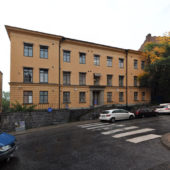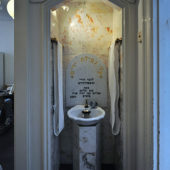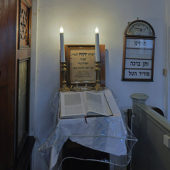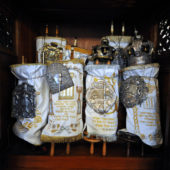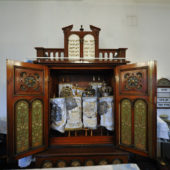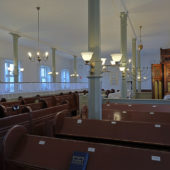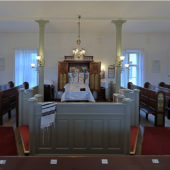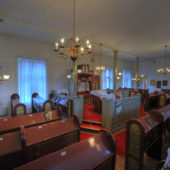The Adas Jeschurun’s interior originally came from a synagogue in Hamburg, Germany which survived Kristallnacht in 1938, and was shipped to Sweden just before the Second World War. The synagogue is situated on the 2nd floor in the building housing the Stockholm’ Hillel School.
Jews were not legally allowed to live in Sweden until the 1770s; prior to that time they lived and practiced their religion in secret. It is recorded that Samson Efraim and his son visited Goteborg and Stockholm on business in 1702. Jewish businessmen increasingly came to Sweden in subsequent years, due to the demands of the East Indian Trading Company. In 1733 Jews were allowed to attend auctions in Goteborg and a small Jewish community of eight people lived in Stockholm until 1734.
Aron Isak, a German seal engraver, was the first Jewish person to receive permission to live in Sweden. He was first offered citizenship if he would become a Christian, to which he replied, “I would not change my religion for all the gold in the world.” This impressed the Lord Mayor of Stockholm, who convinced King Gustav III to grant him citizenship as the first Swedish Jew. He was allowed to bring Jewish families with him so that there would be at least ten Jewish men to hold a minyan (religious/prayer service). By 1775, foreigners (including Jews) were allowed to live on the island of Marstrand, just off the coast of Goteborg. In 1780 the first Jew settled in Goteborg and in 1782, legislation was passed permitting Jews to settle in the cities of Stockholm, Goteborg, Norrkoping, Karlskorna and Marstrand (the latter only from 1775-1794), without converting to Christianity.
In 1776 the first Jewish cemetery in Sweden was established. Seven years later Jews were allowed to build synagogues, perform services and engage in businesses and crafts that were not subject to guilds. In 1838 King Charles XIV began to remove some of the restrictions placed on Jews, allowing them increased civil rights and legal protection. By 1870, the Jewish emancipation increased yet it was not until 1951 that Jews could hold a public office. The Jewish population increased from 900 in 1840 to about 6,500 by 1920. Immigration was regulated following WWI. Fear of a large-scale Jewish immigration led to student demonstrations at Uppsala and Lund Universities in 1938. From 1933 to 1939 only 3,000 Jews were allowed to immigrate to Sweden and an additional 1,000 were allowed to travel through Sweden on to another country.
Once the intent of the Nazi regime became clear, Sweden opened her doors to immigration and was involved in trying to save Jews from the Holocaust, although it was a “neutral” country. In 1942 Sweden permitted 900 Norwegian Jews to immigrate into the country and in October of 1943 gave asylum to over 8,000 Danish Jews who escaped in small fishing boats, as well as the thousands of Hungarian Jews saved by Swedish diplomat Raoul Wallenberg. Count Folke Bernadotte helped bring both Jews and non-Jews out of concentration camps. Sweden also accepted refugees from the Baltic Republic, Lithuania and Estonia. Post WWII, many Holocaust survivors were brought to Sweden for rehabilitation. In 1956 Sweden accepted hundreds of Hungarian Jews fleeing the communist regime and in 1968, accepted thousands more from the communist-led witch-hunts. Jews from Czechoslovakia and Poland immigrated to Sweden, many of whom were intellectuals, university students and young professionals. Between 1945 and 1970 the Jewish population in Sweden doubled. In 2010 the Jewish population of Sweden is approximately 18,000, with the largest community of over 5,500 living in Stockholm.
228 years ago a Reform German community in Sweden emerged in 1774, led by Aharon Yitzchak. Between the first and second World Wars, Jews began arriving from Eastern Europe and the Great Synagogue began practicing Orthodox Judaism, as did the newer shuls in Stockholm, Adas Jeschurun, Adat Jisrael and Baruch Hashem. The community of Jews in the city is considered to be very liberal and the number of religious Jews comparatively is small. However, there is no problem finding Kosher food in Stockholm, thanks to the efforts of Orthodox Rabbi HaRav Meir Horden. The meat is imported from Europe.
Between 1942 and 1943 many Orthodox Jews from Norway and many Danish Jews fled to Sweden, settling in Stockhom. They became an important addition to Jeschurun’s (the people of Israel) religious and social activities. In the spring of 1945, when the concentration camps opened, a new wave of Jewish immigrants settled in Sweden, many of whom also joined Jeschurun. In the spring of 1959, when the congregation received notice that the house they had been worshipping at on Library Street was to be demolished, they settled in a more permanent residence, on the ground floor of the courtyard at Nybrogatan 16 by Autumn of that year. By 1967 the community had outgrown that property and moved across the street to larger, more suitable premises, where they are presently located. The Synagogue is situated on the second floor of the building that houses the Hillel School. Interestingly, when furniture was transferred in the moves, art nouveau, almost gourd style paintings were found, that curators from the National Museum were commissioned to restore. The interior furniture came from a synagogue in Hamburg, which survived the heinous Kristallnacht of 1938 in Germany, and was shipped to Sweden just prior to WWII.
Adas Jeschurun Synagogue has an elegant peach façade with dark brown woodwork on the molding and paned windows. A black wrought iron fence surrounds the property. The prayer room is an unusually wide room, with the back section curtained off for use as the women’s gallery. The room is light with white walls and rectangular, paned windows adorning the back and front walls. Light gray columns are situated throughout the sanctuary. In the center of the prayer room is the bimah, surrounded by light gray wood paneling, with side entrances. The tivah (reader’s desk) sits inside. Against the front wall, behind the tivah, is the Aron Kodesh, a beautiful piece of hand carved art nouveau piece of wood furniture from the synagogue in Hamburg. The doors have insets, which are beautifully painted with art nouveau designs. The spectacular Torah scrolls are inside, protected by velvet embroidered covers, topped with silver crowns and draped with silver chains bearing exquisitely molded silver plaques. At the top of the Aron Kodesh, two tablets are carved, bearing the Ten Commandments, carved in Hebrew. A menorah is placed on the platform to the right of the Aron Kodesh. Simply carved wood benches fill the sanctuary, featuring insets at the ends of art nouveau paintings, matching the Aron Kodesh. These were also brought in from the synagogue in Hamburg. Graceful brass chandeliers light the sanctuary.

